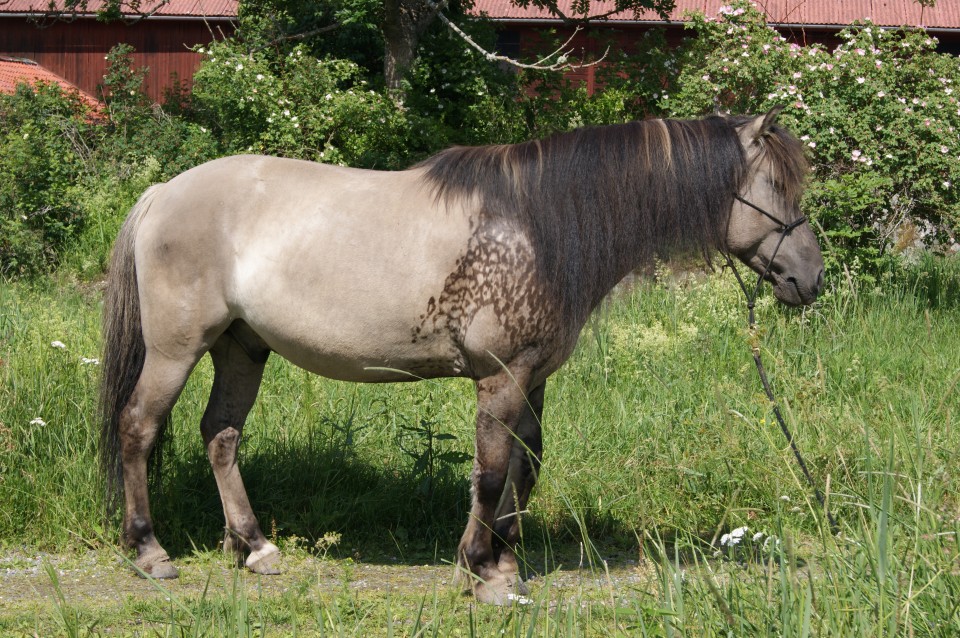It was early in our equine education that we learned the terms for the common white markings found on the head and legs of the horse. At five it’s pretty easy to remember the difference between a star, stripe, snip, and a blaze; between socks and stockings. And our imaginary mounts no doubt came complete with our favorite renditions of these markings (a heart-shaped star…a lightning-bolt blaze) so as to set them apart from all the less important horses in our make-believe herds.

But besides the usual white markings on the head and legs, other white and/or colored markings can be found on other parts of the horse’s body. As horse color specialist and genetic researcher Vera Kurskaya explains in her book “Horse Color Explored“, “they are conditionally called non-standard because they are less common and have a different basis.”
Here are some of the non-standard markings Kurskaya discusses in “Horse Color Explored”:
“
Acquired Markings

Acquired markings. Photo from “Horse Color Explored” by Vera Kurskaya
So-called acquired markings are formed as a result of injuries from grazes, burns, frostbite, and other damage to the horse’s body. One common cause is improperly fitting equipment, especially the saddle. White hair grows in affected areas after extended time or repeated trauma.
Chubari Spots

Chubari markings.
Chubari spots are oval or round, white or whitish spots, usually about the size of an egg. They occur in gray horses but should not be confused with dapples. Chubari spots are randomly scattered on the body of a horse and have sharply delineated borders. With the process of graying, the markings eventually become invisible, having merged with the “white” background.
Chubari spots are most often observed in Thoroughbred and Akhal-Teke horses. Although these markings have a genetic basis, their nature or potential connection with the Gray gene is not clear.
Birdcatcher Markings and Birdcatcher Ticking
Birdcatcher markings received the name commonly used to describe this phenomenon from the Thoroughbred stallion Irish Birdcatcher. They consist of round, white specks with sharp edges (sometimes called flakes) scattered irregularly on the horse’s body. They can appear on a horse with age (foals do not have them) and can also disappear over time. Their number seldom increases, but sometimes they can increase in size.

Birdcatcher markings. Photo from “Horse Color Explored” by Vera Kurskaya
Birdcatcher markings can either be located randomly or concentrated on any part of the body—the shoulder, side, topline. Flakes are often concentrated on the croup, especially on the top, and are surrounded quite often by weak roaning. These marks are observed in particular breeding lines, and may have a hereditary nature. There are some who feel these markings are controlled by genes that are responsible for spotted sabino color. It has been observed that horses with these spots almost always have white markings on the head and legs.
Birdcatcher markings can be found in almost all breeds of horses; most often in Arabians and Thoroughbreds.
Western scientists also recently discovered Birdcatcher ticking. These white specks of very small size are concentrated in the groin, on the croup, hips, withers, along the topline, on the head and neck, and near the base of the tail. Sometimes the ticking is expressed so strongly that it may be mistaken for the roan color, especially in some heavy draft breeds.
Blood Markings

Blood marking. Photo from “Horse Color Explored” by Vera Kurskaya
Blood markings are represented by big red or brown (rarely black) spots and are found only in gray horses. Typically blood markings are found on the horse’s shoulders, but sometimes on other parts of the body, as well. Blood markings can appear as a cluster of spots that form a colored area that doesn’t turn gray with age. Their size varies, from several tiny specks to a sizeable colored area that covers a shoulder, side of the head, or other section of the horse. The color of blood marks does not correspond to the horse’s base color.
There used to be an opinion that blood marks are the consequence of an injury, but it is now established that it is a congestion of pigment. These marks are rare and occur mainly in Arabian horses.
Dark Markings
Occasionally you can find large dark marks on a horse’s body, which—according to Sponenberg (2009)—are similar to birthmarks on people. Their emergence is spontaneous. These spots are rare but all the same can be found on representatives from practically any breed of any color. This said, Sponenberg notes that they are most often seen in combination with bay color and located on a shoulder.
Yellow Spots
Yanova (2003) mentions observation of separate yellow spots, also using a term that means “gray-haired-yellow.” Unlike white markings, yellow spots are characterized by weak hair pigmentation. They are extremely rare, observed only on chestnut and bay horses, and further details related to their nature is, as of writing, unknown.
Bider Markings
In 2007, Japanese and Mongolian scientists found unusual markings on Przewalski horses and native domestic horses of Mongolian origin. These markings are called bider by the Mongolian nomads. They have the appearance of dark stains on the horse’s shoulder blades, shoulder joints, or base of the neck.

Bider marks on a baskkir.
Bider markings can be of any size and have any structure. The underlying skin is also darker than the rest of the body. They are symmetrical in placement, appearing on both sides of the horse’s body. Bider markings are very rare and observed in approximately 1% of Mongolian horses. According to the Japanese and Mongolian scientists from the study, the marks have not been seen in other breeds. I have heard from colleagues, however, that they have also been found in the Bashkir breed and it is said they have been observed in the Yakut horse. They are heritable: It is supposed there is a dominant allele Bi (from “bider”) that is responsible for them.
”

This excerpt from “Horse Color Explored” is reprinted with permission from Trafalgar Square Books.



 June 15, 2017
June 15, 2017 




























